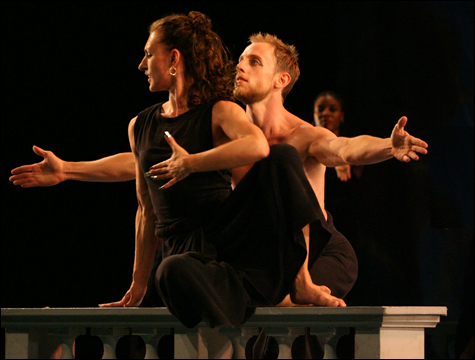
|
In 1989, during his controversial residency in Brussels, Mark Morris created Dido and Aeneas, a dance setting of the hour-long operatic masterpiece that Henry Purcell had composed for performance by the students of Josias Priest’s School for Young Ladies 300 years earlier. It’s the greatest English opera before Handel, and — probably because of its modest requirements — more often revived than almost any other opera in English, though less often “revived” in the sense of being given new life.
For Morris, it became a gender-bending opportunity: he played both Dido, the Queen of Carthage who falls in love with the Trojan prince fleeing from the destruction of his homeland, and her nemesis, a Sorceress bent on Dido’s destruction. The two characters became alter egos, Janus faces: one longing for happiness, the other self-destructive, an embodiment of the impulse we have to undermine our own deepest desires. The Sorceress’s grotesque gestures mimic and mock Dido’s gestures of love and longing. (Dido’s passionate thrust of her hands downward from her chest toward her groin, for instance, gets inverted into a violent upward stomach-to-throat hara-kiri slash.) It was a tour-de-force for Morris the dancer; it was also a profound and moving contemporary interpretation.
The American premiere of Dido took place here in Boston, at the Majestic Theatre in June 1989. Craig Smith conducted the Emmanuel Orchestra, and the late Lorraine Hunt Lieberson sang a heart-rending Dido, with James Maddalena humanizing the cardboard Aeneas of Nahum Tate’s stilted but efficient libretto, tenor Frank Kelley as the voice of the malevolent Sorceress (more gender bending), and soprano Jayne West as Dido’s loving sister, Belinda. It became an instant cultural landmark; yet by 1998, Morris had decided to retire this staple of his repertoire. Was he getting tired of it? He said he was tired of having long hair. And perhaps he was no longer up to his own technical demands.
Then last year, as part of the Mark Morris Dance Group’s 25th-anniversary season at the Brooklyn Academy of Music, he resurrected Dido, with svelte and lithe Amber Darragh as Dido and rambunctious, exuberant Bradon McDonald as the Sorceress. It didn’t work. The insights one dancer in the two opposite roles had provided were lost, along with the concomitant technical excitement.
But Morris has again rethought Dido, and in two performances at Tanglewood’s Seiji Ozawa Hall last Thursday and Friday, Darragh played Dido and the Sorceress one night and McDonald both roles the following night. And though neither dancer has quite the uninhibited wildness and pinpoint control that Morris possessed in his best years as a dancer, or the dominating largeness — and largesse — of his gestures, the real Dido and Aeneas is now back. These were both satisfying performances, and Bostonians will have a chance to see them next May, back at the Majestic, as part of the Celebrity Series of Boston, with Morris conducting.